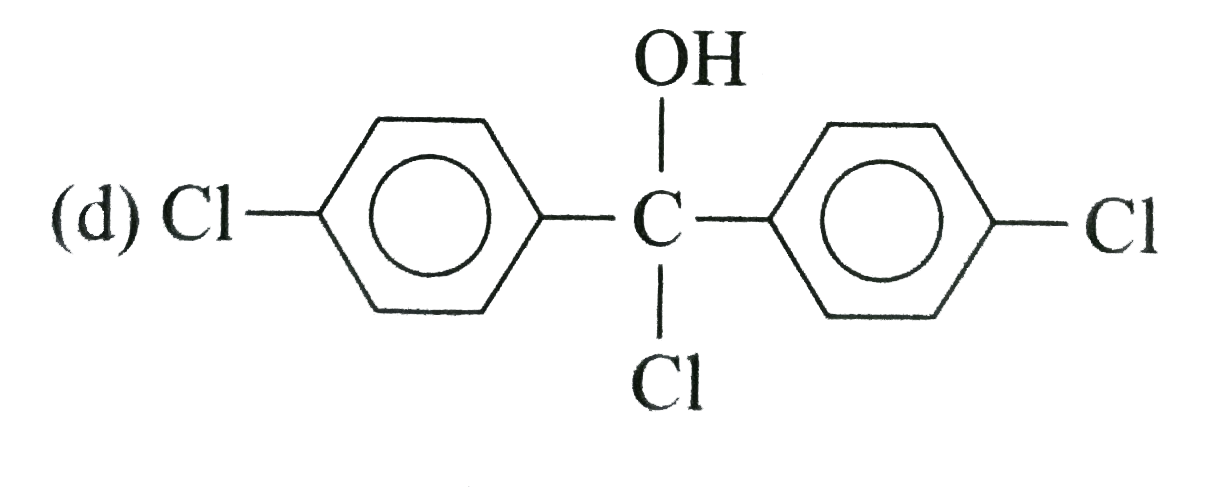Trichlorroacetaldehyde, . Reacts with chlorobenzene in presence of sulphuric acid and produces.




The correct Answer is:A
To solve the problem of what product is formed when trichloroacetaldehyde reacts with chlorobenzene in the presence of sulfuric acid, we can follow these steps:
Step 1: Identify the Reactants
We have the following reactants:
- Trichloroacetaldehyde (CCl3CHO)
- Chlorobenzene (C6H5Cl)
- Sulfuric acid (H2SO4)
Step 2: Understand the Reaction Conditions
Sulfuric acid acts as a dehydrating agent in this reaction. This means it will facilitate the removal of water from the reactants during the reaction process.
Step 3: Reaction Mechanism
1. Formation of an Electrophile: The carbonyl carbon of trichloroacetaldehyde is electrophilic due to the presence of the electronegative chlorine atoms. This makes it susceptible to nucleophilic attack.
2. Nucleophilic Attack: Chlorobenzene can act as a nucleophile. The chlorine atom in chlorobenzene can attack the carbonyl carbon of trichloroacetaldehyde.
3. Formation of DDT: The reaction proceeds with the formation of a compound where the trichloroacetaldehyde is converted into a compound with two chlorobenzene groups attached. The sulfuric acid helps in the dehydration process, leading to the formation of DDT (Dichloro-Diphenyl-Trichloroethane).
Step 4: Write the Product Structure
The product formed from this reaction is:
- The structure of DDT can be represented as:
- CCl3 (from trichloroacetaldehyde)
- Two phenyl groups (from chlorobenzene)
- The overall structure will be CCl3-C6H4-Cl-C6H4-Cl.
Step 5: Final Product Confirmation
The final product of the reaction is DDT, which is represented as:
- C14H9Cl5 (Dichloro-Diphenyl-Trichloroethane).
Conclusion
Thus, the product formed when trichloroacetaldehyde reacts with chlorobenzene in the presence of sulfuric acid is DDT.
---
We have the following reactants:
- Trichloroacetaldehyde (CCl3CHO)
- Chlorobenzene (C6H5Cl)
- Sulfuric acid (H2SO4)
Sulfuric acid acts as a dehydrating agent in this reaction. This means it will facilitate the removal of water from the reactants during the reaction process.
1. Formation of an Electrophile: The carbonyl carbon of trichloroacetaldehyde is electrophilic due to the presence of the electronegative chlorine atoms. This makes it susceptible to nucleophilic attack.
2. Nucleophilic Attack: Chlorobenzene can act as a nucleophile. The chlorine atom in chlorobenzene can attack the carbonyl carbon of trichloroacetaldehyde.
3. Formation of DDT: The reaction proceeds with the formation of a compound where the trichloroacetaldehyde is converted into a compound with two chlorobenzene groups attached. The sulfuric acid helps in the dehydration process, leading to the formation of DDT (Dichloro-Diphenyl-Trichloroethane).
The product formed from this reaction is:
- The structure of DDT can be represented as:
- CCl3 (from trichloroacetaldehyde)
- Two phenyl groups (from chlorobenzene)
- The overall structure will be CCl3-C6H4-Cl-C6H4-Cl.
The final product of the reaction is DDT, which is represented as:
- C14H9Cl5 (Dichloro-Diphenyl-Trichloroethane).
Thus, the product formed when trichloroacetaldehyde reacts with chlorobenzene in the presence of sulfuric acid is DDT.
Topper's Solved these Questions
- ALDEHYDES, KETONES AND CARBOXYLIC ACIDBook:A2ZChapter:ALDEHYDES, KETONES AND CARBOXYLIC ACIDExercise:AIIMS Questions
Explore 40 Videos
- ALDEHYDES, KETONES AND CARBOXYLIC ACIDBook:A2ZChapter:ALDEHYDES, KETONES AND CARBOXYLIC ACIDExercise:Assertion-Reasoning Questions
Explore 7 Videos
- ALDEHYDES, KETONES AND CARBOXYLIC ACIDBook:A2ZChapter:ALDEHYDES, KETONES AND CARBOXYLIC ACIDExercise:Section B - Assertion Reasoning
Explore 33 Videos
- ALCOHOLS, PHENOLS AND ETHERSBook:A2ZChapter:ALCOHOLS, PHENOLS AND ETHERSExercise:Section D - Chapter End Test
Explore 30 Videos
- BIOMOLECULESBook:A2ZChapter:BIOMOLECULESExercise:Section D - Chapter End Test
Explore 30 Videos
Similar Questions
Knowledge Check
Trichloroacetaldehyde, CCI3CHO reacts with chlorobenzene in presence of sulphuric acid and produces
A B
B C
C D
D
Trichloroacetaldehyde, CCl3CHO reacts with chlorobenzene in presence of sulphuric acid and produces.
A B
B C
C D
D
Trichloroacetaldehyde, CCI3CHO reacts with chloro benzene in presence of sulphuric acid and produces
A B
B C
C D
D
Acetylene reacts with nitrogen in the presence of electric spark to produce
View SolutionAlkylation of benzene with isobutene in the presence of sulphuric acid gives
View SolutionThe treatment of benzene with isobutene in the presence of sulphuric acid gives
View SolutionThe treatment of benzene with isobutene in the presence of sulphuric acid gives
View SolutionDehydration of ethanol with sulphuric acid produces
View Solution

